Three subway lines will remain out of service Monday, as the Metropolitan Transportation Authority struggles from staffing shortages due to the surge in COVID-19.
Exactly how many workers are out sick remains unknown, as the MTA continued to withhold information about how badly the massive agency is affected by the spread of the virus, declining to give positivity rates, despite repeated requests.
“Like every business and agency in the region, the MTA is navigating through a spike in workforce positive COVID test results,” said agency spokesman Aaron Donovan in a statement Sunday, Jan. 2. “The Authority is proactively managing to ensure continuation of reliable service 24/7 to every subway station.”
New York City Transit, which manages the subways and buses, took the B, Z, and W lines out of service with announcements on Twitter just before the Thursday morning rush, and MTA plans to keep them offline as New Yorkers return to work and school after the winter break.
All three trains run on routes also served by other lines, and the agency is redirecting crews to ensure continued service on all other lines.
The agency reported cancellations on five subway lines over the New Year’s Eve weekend, including the D, A, L, E, and R, and the Staten Island Railway, according to an amNewYork Metro review of NYCT’s Twitter accounts.
On buses, there were a whopping 52 cancelled runs during that time, 44 of which were on Dec. 31 and largely affecting express bus routes.
Subway ridership compared to pre-pandemic levels slowed in December as the new COVID variant took hold in the Five Boroughs, down to 50% as of the latest count from Dec. 29, following a rise to highs of almost 75% in November.
Bus ridership rates compared to 2019 are also down from similar peaks last month, but remain higher at more than 60% as of Dec. 29.
Donovan declined to give a current infection or vaccination rates among staff — both figures the agency previously made available upon request.
Another spokesperson for the MTA, Renee Price, told this paper on Dec. 27 that the positivity rate was approximately 2% below the city and state numbers, which at the time were just over 19%, but have since climbed to more than 22%, according to the state’s Department of Health.
It is also unclear how many employees are out sick, but MTA acting Chairperson and CEO Janno Lieber told WNYC on Dec. 30 it was at least 1,000 out of the agency’s 67,000-strong workforce, adding that some might be out on vacation.
First-dose vaccination rates were about 80% across the MTA on that date, but subway and bus workers were lower at 73%, according to the radio interview.
The state-run MTA remains one of the few workforces not required to get vaccinated in New York City, unlike city employees and in-person workers at private businesses who are both under a mandate to get the shot.
Instead, the agency relies on a $100 million testing regime for the thousands of its workers who refuse to get inoculated.
One good government advocate said transit officials must be more forthcoming with their data.
“Being transparent about the workforce impacts the MTA is facing due to COVID will only help riders better understand how and why service is being affected,” said Rachael Fauss of the group Reinvent Albany. “Further, sharing data will aid policymakers like our state legislators in making decisions to help the MTA.”



































